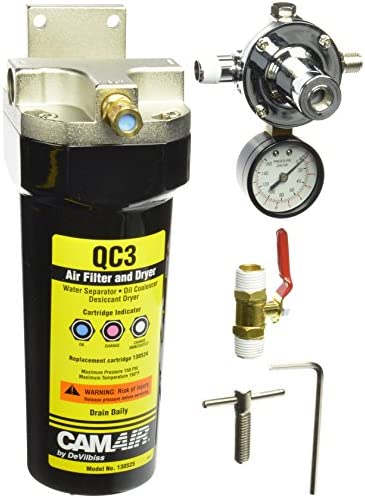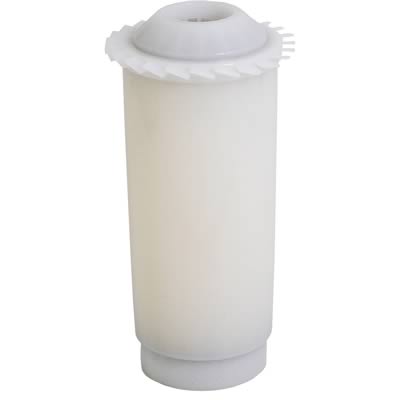Hello all. I just ordered a pro. I’m looking at air dryers while I wait for shipment (btw how long did yours take from order to ship?)
I found this one on facebook. Thoughts?
Hello all. I just ordered a pro. I’m looking at air dryers while I wait for shipment (btw how long did yours take from order to ship?)
I found this one on facebook. Thoughts?
Check the discharge temp on your compressor. Dryer in question has 180° max inlet temp. May need a heat exchanger prior to the air entering it.
Thank you. I looked on it and in the manual and didn’t see a discharge temp. It’s a husky pro 60 gallon
you can just check it with a temp gun towards the end of a cycle.
I wonder what effects it will have beyond possibly increased power usage being oversized rated at 100 cfm?
Air temperature around the compressor is going to have a huge impact of what the temperature will end up being. Also back pressure against the compressor in the form of restriction will also cause an increase in temperature. That husky 60 gallon running in an open-air environment at 70° f likely will have an output temperature North of 200° f. Another huge mistake people make trying to measure temperature on a compressor that they just started, the compressor takes time to get to operating temperature, we really care about what the temperature it would be if you’re running that compressor for an hour actually doing some work .
Another temperature measurement mistake people make is trying to use a infrared thermometer to get a measurement from copper pipe. Copper pipe will reflect other infrared signatures and give user inaccurate measurementa. The best way to measure temperature of a fluid in this case air is with a temperature well. Air moving in a pipe will be a different temperature against the wall surface where the natural friction of the pipe causes the air to move at a different flow rate than the air in the center of the pipe which is moving in laminar flow.
The refrigerated air dryer you have is five times to 10 times the size you need it it will definitely do the job it’ll just cost 5 to 7 times as much power to do it. I think my refrigerated air dryer only has a fifth horse motor where the one you have is running a 3/4 horse motor.
Ideally in almost all refrigerated air dryer situations you’ll want a intercooler before the refrigerated air dryer the only exception would be with a rotary air pump.( you have a Reciprocating air pump which has one of the highest output temperatures.
And after all this you’re still going to want a desiccant dryer to further reduce your air pressure dew point.
Handheld infrared temperature guns are really good for getting the temperature in quite a few static temperature situations on objects with the right surface finish. As far as using an infrared gun in a dynamic temperature situation like compressed air I would move into tools like a clamp-on temperature probe but it’s all possible having a in well temperature probe is ideal when trying to figure out the temperature of fluids.
That refrigerated air dryer you have is a beast. I would see if you could sell that thing for a few thousand bucks and then reinvest in a smaller refrigerated air dryer for your system. Not only will you likely be able to pick up a smaller refrigerated air dryer and keep some money in your pocket the operating cost will make a huge difference over a year or two saving you even more money.
I guess this refrigerated air dryeris one of the expectations for a cooler between it and the compressor.
Here is some information on that piece of equipment
" Pneumatech ADA-100 High Temperature Refrigerated Air Dryer, 100cfm, 115V
Pneumatech high temperature refrigerated air dryers are designed specifically for use with piston and reciprocating air compressors without an aftercooler. Whereas a standard refrigerated dryer is only capable of handling cooler incoming air, the ADA series of high temp fridge dryers are capable of handling inlet compressed air temperatures of 180F degrees."
its worth about 5000$ us and is way overkill for you.
Wow some nice features though !
" Pneumatech ADA-100 Standard Features
And @Ldouble619 Welcome to the forum
I think yours is a older version since the new ones are running r404 instead of R134
YUP…my recent upgrade to my little one…hehehehe
so this is a standard water filter…rated for 100lbs…I have a 1/2" copper pipe inside with a bug screen on the bottom to prevent beads from getting sucked up…but I still have the MotorGuard in line before the plasma…
air drops in the from the top of the filter through all the beads and into the copper pipe…
once I finish the wall cooler I will show the rest…
@toolboy what inlet pressure are you running? I have thought about doing one of these but the pressure and the bowl failing has left me hestitant to try it. I did think about making a metal guard to go arpund it made out of expanded metal so woukd contain it somehwat if it did fail. But i suspest even being rated for 100 psi the actual fail point should be even way higher.
Your install looks clean! I too like @Dobber also would be hesitant using that vessel for compressed air.
My logic goes like this for the situation:
yes, 100psi of water and 100psi of air are at the same pressure.
but…
Water does not not compress air does making compressed air much more volatile and dangerous then compressed water.
If it is a viable option to use this plastic for air pressure vessels at a reduced price why don’t manufactures of desiccant canisters use it?? ( I know there are smaller air filters that use this plastic but the consequence of a failure go up massively with a increase in volume)
I have used them in the past with many wraps on tape around them but not any more.
I run 120 on my line pressure off the compressor…the unit is rated at 100psi…so standard safety is usually done at 1.5 above rating…even if it was safety at .5 over operating I am still fine…not worried…
even my smaller one from Campbell Hausfeld was plastic…but had a thin aluminum case around it…in fact the plastic is so thin on this you can squeeze it…the big one is around 1/4" thick…
because most people do not want it that big…and the cost of them being soo big makes the average purchase out of reach…
I would bet the smaller one is a different plastic that would split open instead of explode.
I worked in a shop that had PVC airlines and never had a problem. Some people have had them explode.
I had a friend that had a small portable craftsman air compressor maybe 30 years old and he used it the other day and the tank exploded (rusted out). No one around when it happened but it did mangle the tank. Ever wonder how many people have had the tanks checked on old compressors? That would be a good idea too. There is always going to be the debate on how safe is safe. ![]()
that is why I do a lot to control moisture in the tank…I have drains…and I do a visual every couple of years from the inside…
I may eventually find a piece of steel pipe that fits around it to just hang around to protect outwards shrapnel if it ever goes…
@toolboy what brand water filter is that one. Still on the fence about doing one but if i do i am going to just putva good guard arpubd it incase it decides to fail. I know also know that some people that have had PVC pipe fail is because their air was too hot and i suspect hot air would do the same to this. But going through two coolers and refrigerated drier the air should be plenty cool. Working on building my new system now so trying to use the best ideas in it all at one time and not have any issues.
@toolboy thanks. I think I have looked ar several of those already but did not realize yours was those. I think i have looked at a million different things for filters, coolers and dessicant units lately.
yes the one caveat I made above.
the aluminum is the structure of the small filter.
most people here don’t need a filter for 30 cfm
this is only 150 $ and is 22 cfm. ( I’m not sure the CFM is accurate on this but Campbell Hausfeld does a really bad job of giving the specs for their air products(edit: doubtful this is 22 cfm now))
This is the desiccant filter I use it’s almost doubled in price in the last couple years they sell a slightly cheaper version of this at Eastwood as well.

this CAM-air is rated at 16 CFM which is about perfect for our small plasma set ups
also the rainfresh FC-200 you install has a maximum pressure rating of 100 psi, both the brochure and install manual recommends operating it at 75 psi or less and is there is any chance of it being a higher psi to install a regulator set to 75 psi . “Recommended regulator setting is 60 - 75 psi”
also the cannister or sump has a limited service life of 5 years in its ideal conditions before a replacement is needed. which is filled with cold water out of sunlight (I would think UV from the plasma and lack of cooling that the water provided would reduce this service life even further).
@TinWhisperer can the cartridge for the Devilbliss unit be opened up and the beads baked to reuse them? I thought i had seen a thread saying could be done but cant remember where i saw it.
yes they can be. I have two of the internal cartridges’ that I swap.
